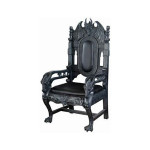Gothic Style
by Phoenix, HSM team writer
If you ever wanted to go Goth, but wasn’t certain how, why not try some Gothic interior decoration in one of your Home estates?
The Gothic world of furniture design is thriving in Home, as is the Gothic fashion world in Home. There are several spaces in Home designed with Gothic architecture, and the furnishings created by Konami and Lockwood are perfect for these — and, actually, any personal space that you want to give that particular look to.
The term “Gothic” is often misunderstood; as a result, some people stay away from things labeled Gothic because of this misunderstanding. The Gothic style is a stunningly visual style that has lasted for centuries since its creation, and will no doubt last for centuries to come. So, let’s look at the elements of Gothic design and give a little history of Goth for those that want to use it but aren’t certain of its origins.
First of all: the Gothic movement was not created in some dark cave with candles lit upon an altar, athamé in the hand of some gruesome fiend, held high above a heavy breasted maiden, breathing frantically while she awaits the saving hero. No. Gothic furniture elements derive from Gothic architecture; it is a very ornate and unique form of artwork containing the same elements found in church design of the 13th century throughout countries in Europe, but on a smaller scale. These furnishings were designed to complement the churches, and later other structures created in that style. Church design in the 13th century followed the cathedral style; either on a small scale or large, these churches were created with all the elements present you will find later in Gothic furniture.
These elements are: intricate and heavily carved, decorative paintings, dark woods, and very elaborately done sculptures. Though created in the style of the churches, these features were quickly copied in the building of wealthy homes of the time. The patrons of churches at the time wanted the same look as the churches they helped to fund, and so the Gothic style began to spread to the private sector.
Elemental characteristics that appear and seem to dominate the furniture are gargoyles, flying buttresses, and quatrefoil, trefoil shapes, along with pointed arches (this is an important distinction, as there are several styles of arches). Gothic design uses pointed arches like those found in medieval churches and cathedrals. Heavy fabric, heavy woods and some other characteristics mark this style in furniture history. (I might note this style of furnishings was popular in the Middle Ages as well, and found a revival in the Victorian period due to novels of kidnapped heroines and the ever popular vampire genre).
Other elements found in Gothic furniture as well as architecture follow motifs, found popular in the 13th century, such as roses, wheels, linen-fold, and so forth. All were part of the building design transformed to the detailing of the furnishings. Colors popular in Gothic furniture are gold, ruby, purple and forest green, these deep rich colors highlighted the furnishing details and dark woods like walnut, oak, rosewood with its pinkish red glow, and many other heavy woods used at the time. These woods were darkened even further with the use of a dark patina. The
fabrics used in these designs were of course of a same rich caliber: brocade fabric, leathers, velvets, all were used to upholster furnishings. Elements in Gothic furnishing were simple in thought; they were thought to be long lasting, and so were made to be sturdy and robust. The goal was one of practicality and simplicity.
In this period of history there were no closets as we know them today; they were not built into a wall in your home, so the armoire or wardrobe was widely used. Sideboards and chests were used to store household goods and secured valuables. In the middle ages, the furniture had to be moved about in a possible siege, and the heaviness of it could come in handy to protect someone in those days. It was at this time chests gained the addition of feet, some being claws in shape, and chairs gained backs, some becoming high and arched. These chairs soon became a thing of art and a display of wealth, being covered in the fabric affordable to the owners; and backs growing higher and more intricately covered in sculptures until they resembled thrones and not chairs.
 Beds began to become more stylized with painted woods, carvings and sculptures. These beds grew larger and heavier in this transformation, with heavy velvet curtains and bedding being added. Tables began to be made of gold and silver with intricately detailed filigree and motifs of vines and roses decorating them as well as the church gargoyles, in the homes of the wealthy. In homes of lesser incomes, tables and some other items were cast form marble and stone. All of these elements in design were eventually mixed and used to become the look we know today as dark and sometimes sinister, sometimes theatrical.
Beds began to become more stylized with painted woods, carvings and sculptures. These beds grew larger and heavier in this transformation, with heavy velvet curtains and bedding being added. Tables began to be made of gold and silver with intricately detailed filigree and motifs of vines and roses decorating them as well as the church gargoyles, in the homes of the wealthy. In homes of lesser incomes, tables and some other items were cast form marble and stone. All of these elements in design were eventually mixed and used to become the look we know today as dark and sometimes sinister, sometimes theatrical.
Whatever your idea of Gothic is, there is no denying the look and curious pull of the design elements. There is something attractive in Gothic furnishings. These elements have lasted for centuries, and have a place in the furniture world as well as Home. So whether you like it at first glance or are repulsed and find it dark and creepy, or if the dark and creepier style of Gothic design is your style, check out the furnishing on offer in Home, it may actually become your style after all.
Share
| Tweet |




